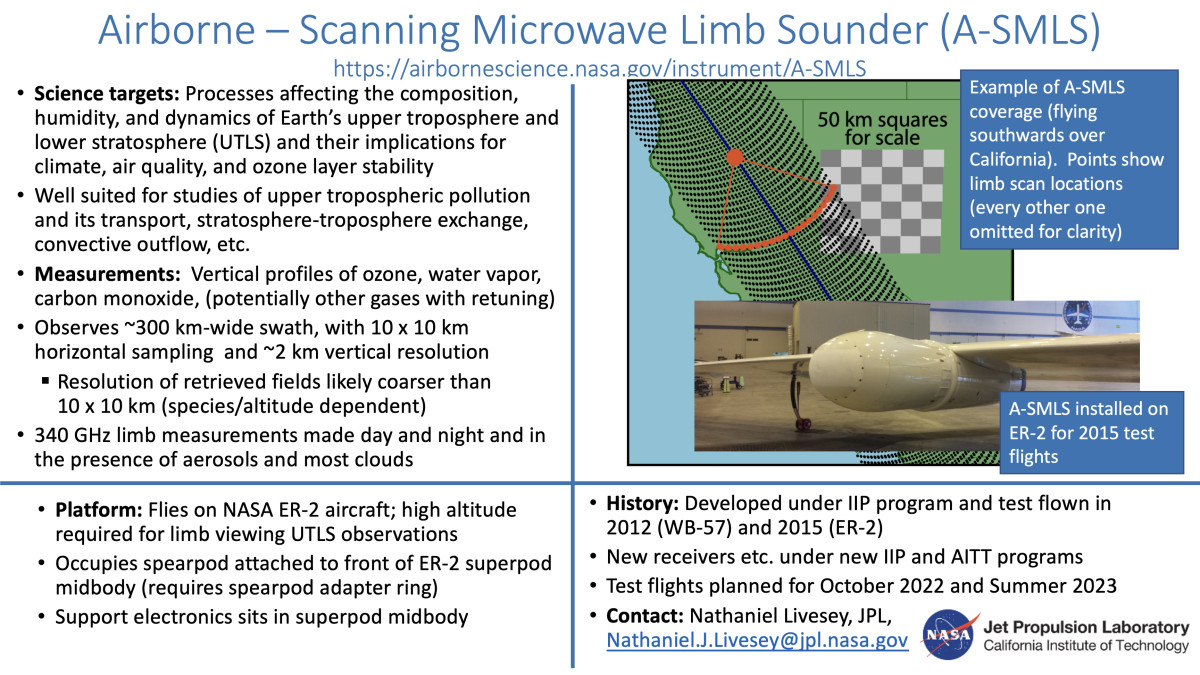Airborne - Scanning Microwave Limb Sounder

The Airborne Scanning Microwave Limb Sounder (A-SMLS) instrument
A-SMLS is an instrument designed to fly onboard the NASA ER-2 aircraft, making wide-swath vertical profile observations of the composition of the upper troposphere and lower stratosphere (UTLS, ~10 – 20 km altitude) at 340 GHz. Observing a ~300km-wide swath ahead of the aircraft in a 2D raster scan (azimuth and elevation), A-SMLS is designed to measure water vapor, ozone, and carbon monoxide with a 10 x 10km horizontal resolution (across and along-track). See Table 1 for more details on the key A-SMLS capabilities and parameters.
A-SMLS is ideally suited to provide high spatial resolution measurements of UTLS composition needed to improve our understanding of key atmospheric processes including:
- Convective uplift of air and associated trace gases from the surface to the upper troposphere.
- Long-range transport of pollution plumes (including those uplifted by convective).
- Air exchange between the troposphere and the stratosphere.
As such, A-SMLS observations from the ER-2 will prove to be a valuable asset in future multi-instrumental field campaigns, e.g. utilizing the wide swath to provide context for more detailed in-situ measurements by aircraft in the stratosphere or at lower altitudes.
Additionally, A-SMLS presents a unique opportunity as a pathfinder for future MLS class instruments, using the latest generation receivers and spectrometers to demonstrate these technologies in advance of them being proposed for future spaceflight opportunities.
A-SMLS was originally developed under NASA’s Instrument Incubator Program and flew on the WB-57 aircraft in July and September 2012. This version of the instrument used 4 K-cooled superconducting microwave receivers, requiring a liquid Helium-filled dewar. The instrument was subsequently adapted for the NASA ER-2 aircraft, on which it flew in March 2015.
A-SMLS was recently updated to use new 340 GHz microwave receivers that can operate both at room temperature and at cryogenic temperatures. A new mechanical cooler was installed to hold the receiver at ~70 K, removing the need for liquid helium cooling. Upgrades to the mirror pointing system and pilot instrument control and aircraft telemetry interface are underway. Test flights of this new configuration are planned for Summer/Fall 2023.
Table 1: Key A-SMLS parameters.
Fundamental measurement: | Vertical profiles of atmospheric composition from ~8–20 km altitude |
Primary target gases: | Ozone (O3), Water vapor (H2O) and Carbon Monoxide (CO) |
Additional observable speciesa: | HNO3, N2O, H2CO, ClO, HOCl, BrO, HO2, OH, CH3CN, HCN, CH3Cl, CH3OH, SO2, Temperature, Cloud Ice |
Spectral coverage: | 320–360 GHz |
Sidebands: | Sideband separating (I/Q frontend, analog or digital separation) |
IF processing: | 2 splitters, 4(b) bandpass filter/attenuator/amplifier chains |
Spectrometersa: | Two 3-GHz wide digital spectrometer system on Chip devices with analog sideband separation. |
Signal-to-noise: | 1700 K per sideband or better system noise temperature at ambient. 330 K when cooled to 70 K. |
Limb scan: | Completely programmable. Capable of scanning ±30° horizontally on either side of the flight direction, with a ±4° vertical scan. |
Coverage: | The horizontal scan gives a 300 km-wide swath from ER-2 flight altitudes. |
Location: | Accommodated in fore- and mid-body of NASA ER-2 aircraft wing pod. |
a Currently, with the 3-GHz wide spectrometers, observations of some of these molecules require minor
instrument retuning.
Science lead: Nathaniel Livesey
Team: Frank Winiberg, Luis Millán, Adrian Tang, Jacob Kooi, Carl Percival, Timothy Crawford, Barry Winestock
Keywords: troposphere, stratosphere, convection, pollution, transport
